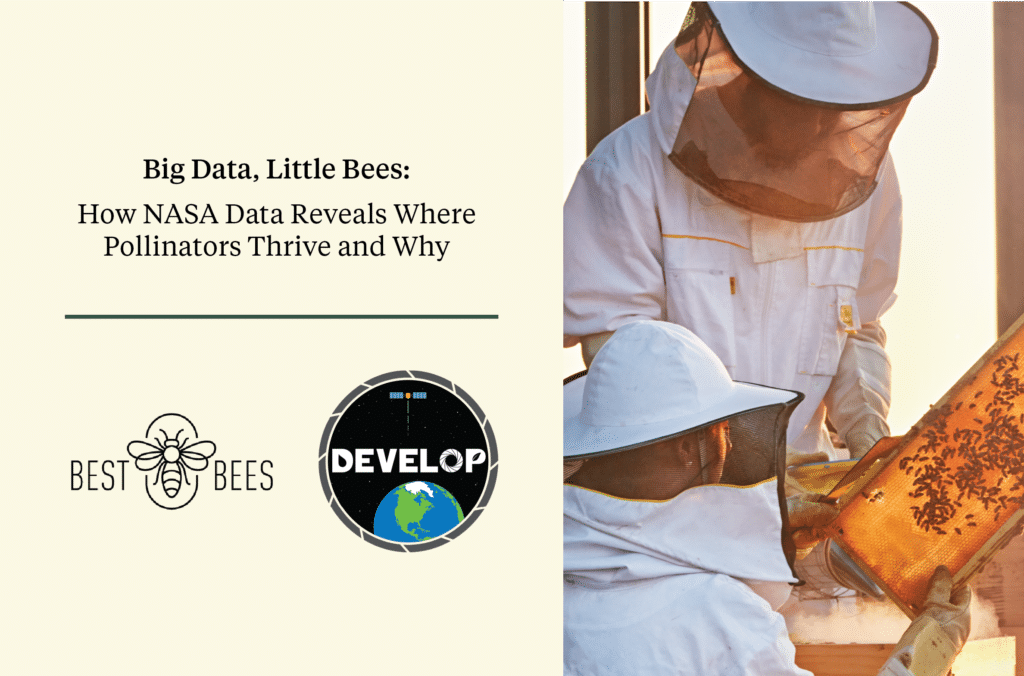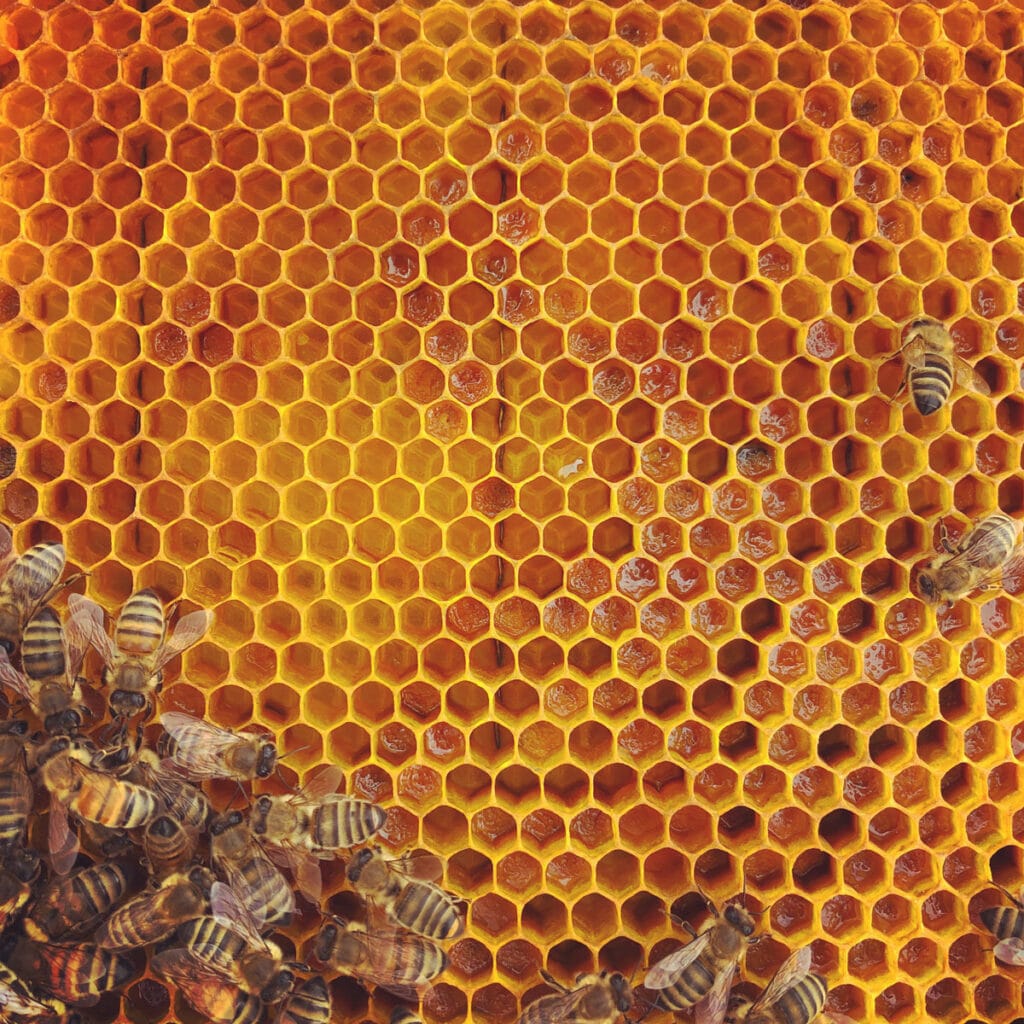Last month we hosted a webinar with Darcy Grey of NASA Develop. We aimed to inspire and educate our audience on the many ways data can advance the health of pollinators. Check out some key takeaways below!
What We Learn From Bees
Beyond the direct benefits of food, flowers, and honey, bees also give us a view of life and of our planet that we wouldn’t otherwise be able to see.
By studying bees, we can make a measurable impact to drive real change on accomplishing goals relating to:
- Plant biodiversity: By analyzing honey, we are able to have a better understanding of a beehive’s surrounding environment and its floral diversity.
- Disaster recovery: This information, made possible by our HoneyDNA research, can identify the presence of invasive species in certain locations before and after natural disasters, thus informing the planning of restoration efforts.
- Climate change: As our climate changes, so will our honeybee population. To better prepare for these changes, we are using Geographic Information Systems (GIS) to map and research “Blue Zones” in which honey bees live longer and identify what environmental factors contribute to their longevity.
- Social dynamics: Honeybees are social insects, meaning they are a well-organized unit that works in unity to advance the colony as a whole. As humans, we can look to their behavior to better understand how social dynamics such as communication, specialized divisions of labor, environmental control, and more influence the success or failure of a society.
- Spread of disease: Honeybees have lived for millennia, withstanding a variety of threats such as disease. Earlier this year, we shed light on some important things we can learn from bees during the COVID-19 crisis.
Looking at Pollinator Health from Space
A large part of the research done at NASA is Earth science research. NASA has a network of satellites which look down at Earth and collect data, aka NASA Earth observations. These satellites collect images, with cameras allowing us to visually see earth from space, but many of them, through different methods, also capture metrics that we can’t see with our eyes. These factors include: thermal radiation, precipitation, infrared and other non-visible light sources.
The relationship between honeybees and the environment is a complex one. And while scientists have a number of tools to investigate this, no tool will really provide a full picture on its own. The NASA Develop project aimed to provide end-users with a way to visualize some of the factors associated with bee health from space..
Satellite imagery of an apiary’s foraging radius, overlapped with NASA Earth Observations.
Bringing Us Back to Earth: Habitat Hypothesis
No one tool can help save the bees, but a variety of scientific studies and advancements can bring us closer. One hypothesis, the habitat hypothesis, posits that nutrition plays a key role in beehive productivity and longevity. To test this hypothesis, we needed a way to measure honeybee nutrition. We did this through our state of the art HoneyDNA research.
HoneyDNA informs us about the plant environment surrounding beehives, measuring ecosystems like never before, using advanced genomics to look at DNA, just like AncestryDNA or 23 and Me do for humans.
Understanding where bees foraged reveals which plants best feed pollinators in the local environment.
Take Action
The heart of Best Bees’ mission is to celebrate and promote citizen science. We aim to give everyday people the tools they need to help the health of pollinators. Here are 5 things you can do to save the bees:
- Advocate for bees: Use your voice, your IG, your Facebook page, to share information about bees. Look around at the physical spaces and resources you have, and what can be done with them. Ask your employer: what are you doing with that empty space? Let’s turn it into a small garden or pollinator habitat.
- Plant native wildflowers: Even though we don’t usually think of planting flowers this time of year, there are still some great things you can do. Planting now yields flowers in the spring. For more on what to plant, check out our blog. If you don’t think of yourself as a gardener, try guerilla gardening: take a handful of native wildflowers, throw them in a vacant lot, and see what grows!
- Get bees: Sign up for a professional beekeeping service, like ours! Professionally-managed beehives are a low-maintenance, high-impact option for those interested in expanding the bee population. Alternatively, take a local beekeeping class and do it yourself.
- Get honeyDNA Reports: By analyzing the DNA in honey, you will help inform disaster preparedness efforts, identify the presence of invasive species, and serve as tasting notes for your next charcuterie platter with your friends, even virtually! HoneyDNA lets you learn what your bees like in your area. If you don’t have beehives, you can get this analysis for a friend.
- And lastly, Use the NASA data: For both the professional scientists and citizen scientists in the audience, tap into ARSET, that’s NASA’s Applied Remote Sensing Training resource. It covers the basics, for those who have never touched it before, to more advanced topics, and includes live and on-demand, free webinars. This resource is for anyone who wants to learn how to use satellite data to investigate questions about almost anything!
Interested in learning more? Click here to watch the webinar in full!
Resources:
DEVELOP: https://develop.larc.nasa.gov/
HIVE-OS: https://github.com/NASA-DEVELOP/HIVE-OS
Native Plant Finder: https://www.nwf.org/nativeplantfinder/
Pollinator Conservation Seed Mixes from Xerces Society: https://xerces.org/pollinator-conservation/pollinator-conservation-seed-mixes








